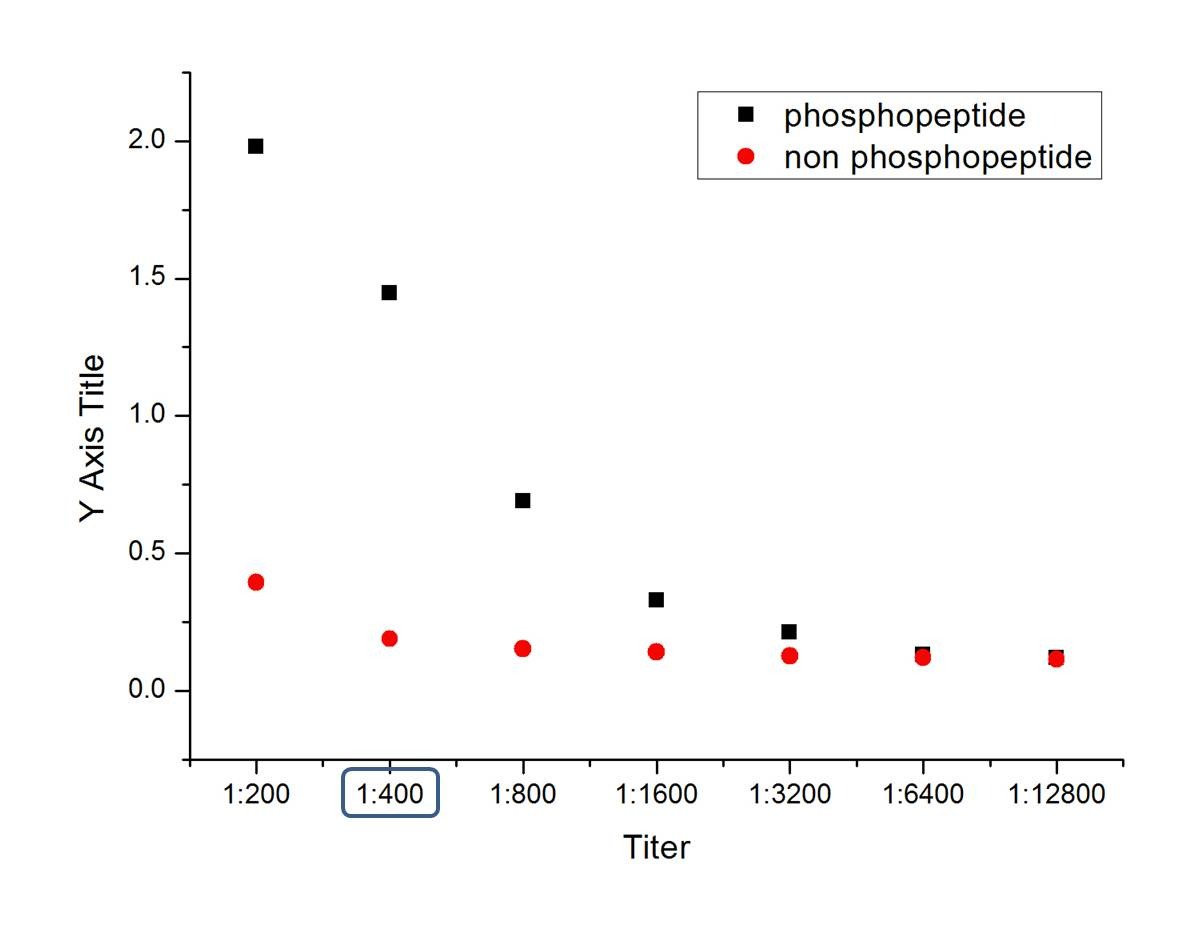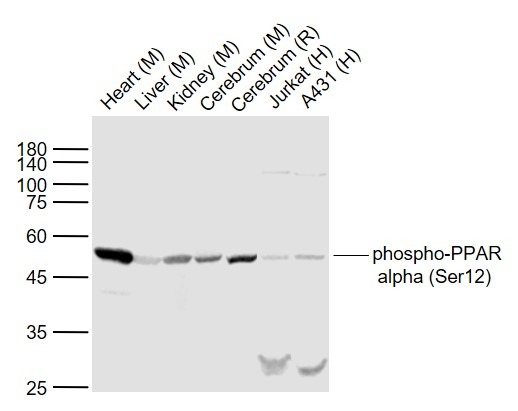 您的购物车当前为空
您的购物车当前为空
Anti-Phospho-PPAR alpha/PPARA alpha (Ser12) Polyclonal Antibody
一键复制产品信息别名 p-PPAR alpha/PPARA alpha (Ser12), p-PPAR alpha/PPARA alpha (S12), PPAR-α, PPARα, PPAR-alpha, PPARalpha, PPAR alpha/PPARA alpha (p-Ser12), PPAR alpha/PPARA alpha (p-S12), Ppar, peroxisome proliferator-activated receptor α, peroxisome proliferator-activated receptor alpha, Nr1c1, AW742785, 4933429D07Rik
Anti-Phospho-PPAR alpha/PPARA alpha (Ser12) Polyclonal Antibody 是一种 Rabbit 抗体,靶向 Phospho-PPAR alpha/PPARA alpha (Ser12)。Anti-Phospho-PPAR alpha/PPARA alpha (Ser12) Polyclonal Antibody 可用于 ELISA,IF,IHC-Fr,IHC-P,WB。
Anti-Phospho-PPAR alpha/PPARA alpha (Ser12) Polyclonal Antibody
一键复制产品信息Anti-Phospho-PPAR alpha/PPARA alpha (Ser12) Polyclonal Antibody 是一种 Rabbit 抗体,靶向 Phospho-PPAR alpha/PPARA alpha (Ser12)。Anti-Phospho-PPAR alpha/PPARA alpha (Ser12) Polyclonal Antibody 可用于 ELISA,IF,IHC-Fr,IHC-P,WB。
| 规格 | 价格 | 库存 | 数量 |
|---|---|---|---|
| 50 μL | ¥ 1,160 | 5日内发货 | |
| 100 μL | ¥ 1,965 | 5日内发货 | |
| 200 μL | ¥ 2,790 | 5日内发货 |
Anti-Phospho-PPAR alpha/PPARA alpha (Ser12) Polyclonal Antibody 相关产品
产品介绍
| 产品描述 | Anti-Phospho-PPAR alpha/PPARA alpha (Ser12) Polyclonal Antibody is a Rabbit antibody targeting Phospho-PPAR alpha/PPARA alpha (Ser12). Anti-Phospho-PPAR alpha/PPARA alpha (Ser12) Polyclonal Antibody can be used in ELISA,IF,IHC-Fr,IHC-P,WB. |
| 别名 | p-PPAR alpha/PPARA alpha (Ser12), p-PPAR alpha/PPARA alpha (S12), PPAR-α, PPARα, PPAR-alpha, PPARalpha, PPAR alpha/PPARA alpha (p-Ser12), PPAR alpha/PPARA alpha (p-S12), Ppar, peroxisome proliferator-activated receptor α, peroxisome proliferator-activated receptor alpha, Nr1c1, AW742785, 4933429D07Rik |
| Ig Type | IgG |
| 交叉反应 | Human,Mouse,Rat,Rabbit (predicted:Dog,Pig,Cow,Horse,GuineaPig) |
| 验证活性 | 1. phosphopeptide non phosphopeptide 2. Tissue/cell: rat kidney tissue; 4% Paraformaldehyde-fixed and paraffin-embedded; Antigen retrieval: citrate buffer (0.01M, pH6.0), Boiling bathing for 15 min; Block endogenous peroxidase by 3% Hydrogen peroxide for 30 min; Blocking buffer (normal goat serum) at 37°C for 20 min; Incubation: Anti-phospho-PPAR alpha (Ser12) Polyclonal Antibody, Unconjugated (TMAB-01483) 1:200, overnight at 4°C, followed by conjugation to the secondary antibody and DAb staining. 3. Sample: Lane 1: Heart (Mouse) Lysate at 40 μg Lane 2: Liver (Mouse) Lysate at 40 μg Lane 3: Kidney (Mouse) Lysate at 40 μg Lane 4: Cerebrum (Mouse) Lysate at 40 μg Lane 5: Cerebrum (Rat) Lysate at 40 μg Lane 6: Jurkat (Human) Cell Lysate at 30 μg Lane 7: A431 (Human) Cell Lysate at 30 μg Primary: Anti-phospho-PPAR alpha (Ser12) (TMAB-01483) at 1/1000 dilution Secondary: IRDye800CW Goat Anti-Rabbit IgG at 1/20000 dilution Predicted band size: 53 kDa Observed band size: 50 kDa    |
| 应用 | ELISAIFIHC-FrIHC-PWB |
| 推荐剂量 | WB: 1:500-2000; IHC-P: 1:100-500; IHC-Fr: 1:100-500; IF: 1:100-500; ELISA: 1:5000-10000 |
| 抗体种类 | Polyclonal |
| 宿主来源 | Rabbit |
| 亚细胞定位 | Nucleus. |
| 组织特异性 | Skeletal muscle, liver, heart and kidney. |
| 构建方式 | Polyclonal Antibody |
| 纯化方式 | Protein A purified |
| 性状 | Liquid |
| 缓冲液 | 0.01M TBS (pH7.4) with 1% BSA, 0.02% Proclin300 and 50% Glycerol. |
| 浓度 | 1 mg/mL |
| 研究背景 | Peroxisome proliferators are nongenotoxic carcinogens which are purported to exert their effect on cells through their interaction with members of the nuclear hormone receptor family, termed Peroxisome Proliferator Activated Receptors (PPARs). Nuclear hormone receptors are ligand dependent intracellular proteins that stimulate transcription of specific genes by binding to specific DNA sequences following activation by the appropriate ligand. Studies indicate that PPARs are activated by peroxisome proliferators such as clofibric acid, nafenopin, and WY-14,643, as well as by some fatty acids. It has also been shown that PPARs can induce transcription of acyl coenzyme A oxidase and cytochrome P450 A6 (CYP450 A6) through interaction with specific response elements. PPAR alpha is activated by free fatty acids including linoleic, arachidonic, and oleic acids. Induction of peroxisomes by this mechanism leads to a reduction in blood triglyceride levels. PPAR alpha is expressed mainly in skeletal muscle, heart, liver, and kidney and is thought to regulate many genes involved in the beta-oxidation of fatty acids. Activation of rat liver PPAR alpha has been shown to suppress hepatocyte apoptosis. PPAR alpha, like several other nuclear hormone receptors, heterodimerizes with retinoic X receptor (RXR) alpha to form a transcriptionally competent complex. |
| 免疫原 | KLH conjugated synthesised phosphopeptide: human PPAR alpha around the phosphorylation site of ser12 |
| 抗原种属 | Human |
| 基因名称 | Ppara |
| 基因ID | |
| 蛋白名称 | Peroxisome proliferator-activated receptor alpha |
| Uniprot ID | |
| 研究领域 | Metabolism of lipids and lipoproteins,Response to hypoxia,Nuclear hormone receptors,Metabolism,Zinc Finger,Fatty acids,Lipid metabolism,Mitochondrial transcription,Hypoxia,Mitochondrial Biogenesis,Fatty acid oxidation,Obesity |
| 功能 | Ligand-activated transcription factor. Key regulator of lipid metabolism. Activated by the endogenous ligand 1-palmitoyl-2-oleoyl-sn-glycerol-3-phosphocholine (16:0/18:1-GPC). Activated by oleylethanolamide, a naturally occurring lipid that regulates satiety (By similarity). Receptor for peroxisome proliferators such as hypolipidemic drugs and fatty acids. Regulates the peroxisomal beta-oxidation pathway of fatty acids. Functions as transcription activator for the ACOX1 and P450 genes. Transactivation activity requires heterodimerization with RXRA and is antagonized by NR2C2. |
| 分子量 | Theoretical: 52 kDa. |
| 储存方式 | Store at -20°C or -80°C for 12 months. Avoid repeated freeze-thaw cycles. |
| 运输方式 | Shipping with blue ice. |





 还可以
还可以

 |
|
评论内容